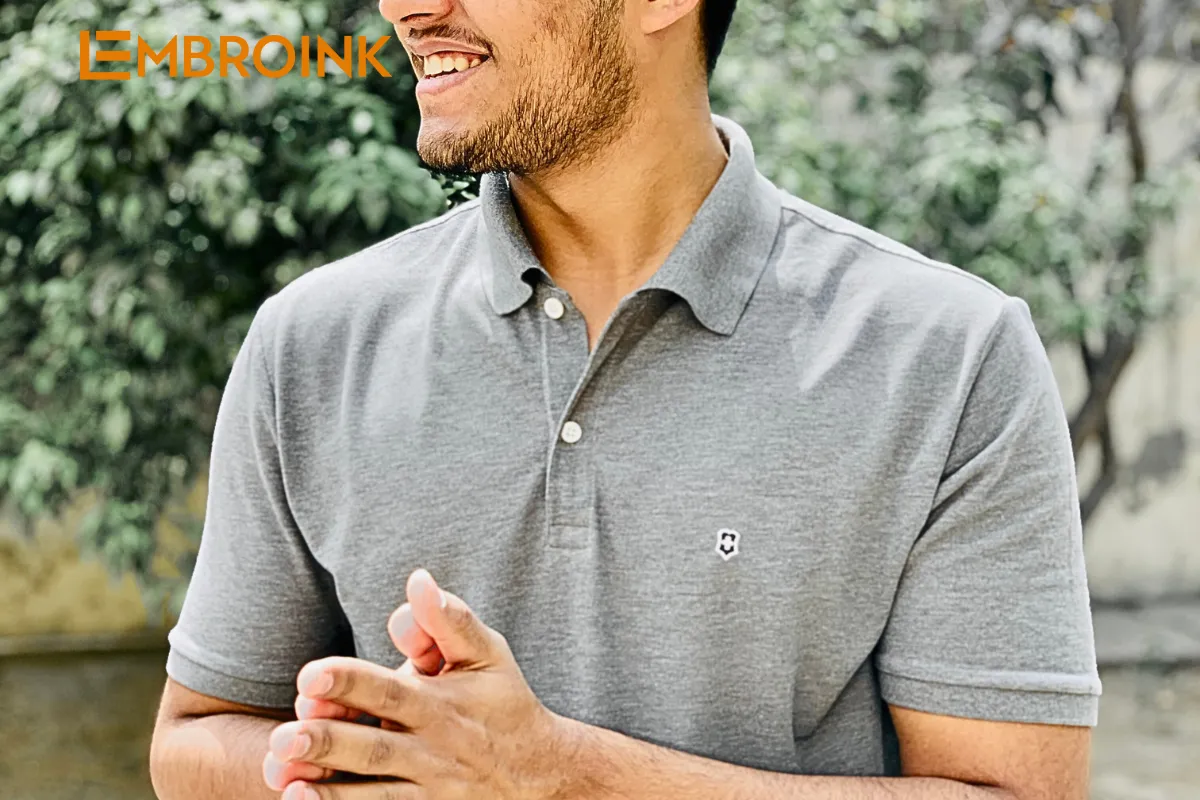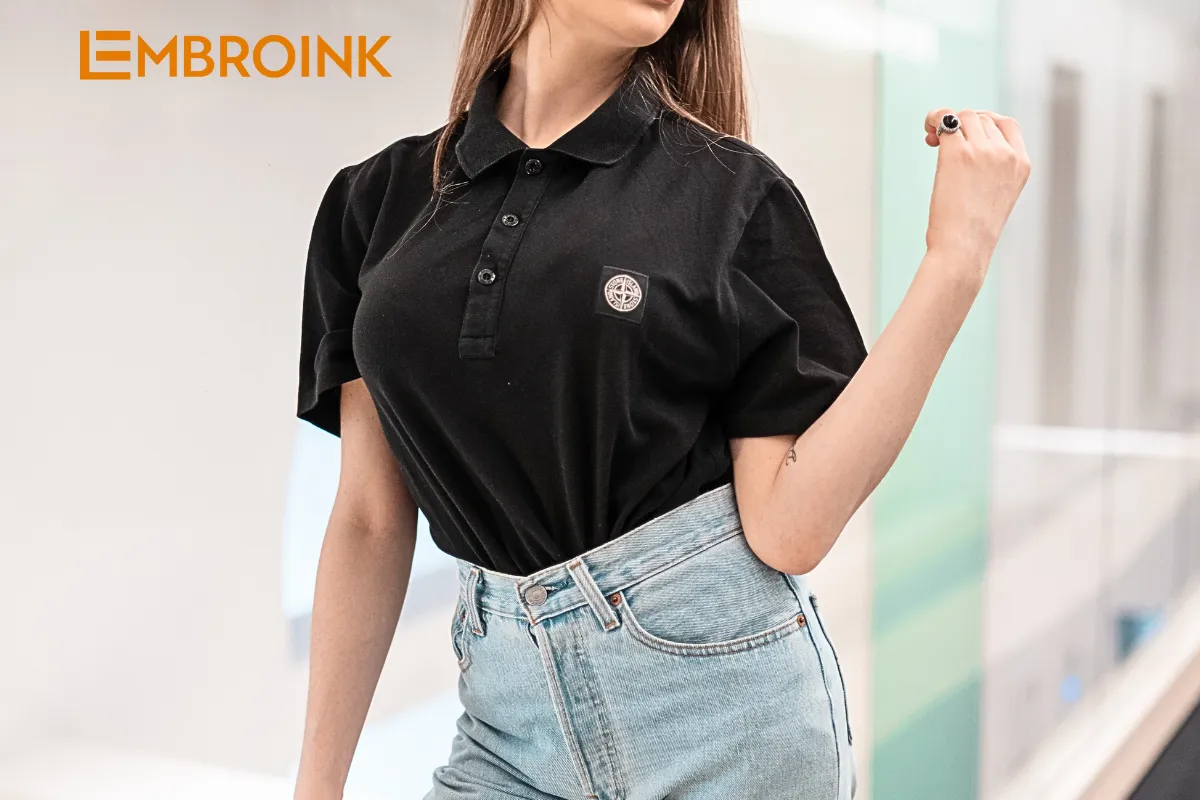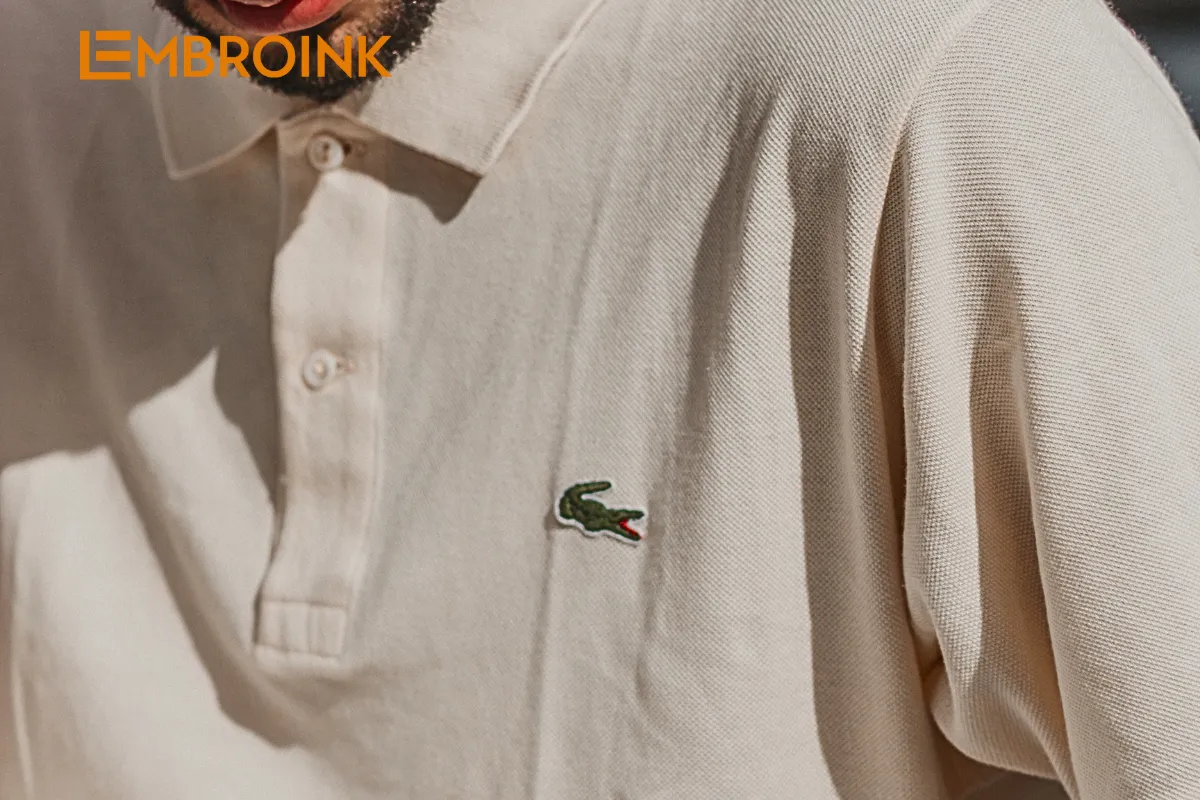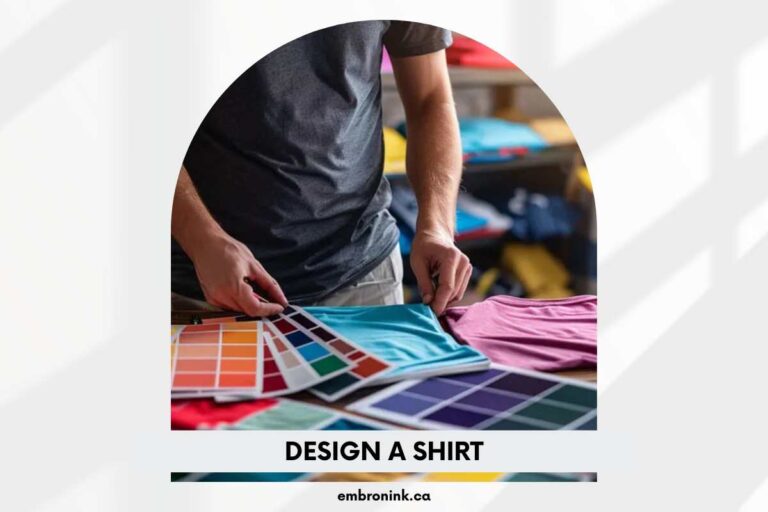How to embroider a business name on a polo shirt?
Embroidered polo shirts are always popular due to their convenience and uniqueness. The demand for these shirts is increasing, as everyone wants to own an embroidered polo shirt. However, embroidery workshops often only accept large orders and require customers to provide their own shirts. EmbroInk offers affordable embroidery services for business names on polo shirts, with quick service and high-quality products.
What is a Polo Shirt?

What is a Polo Shirt?
A Polo Shirt is a type of T-shirt but it is called a Polo T-shirt. It is a type of T-shirt with a fold-over collar (also known as a buttoned placket). Polo shirts are designed to be suitable for both men and women.
Additionally, a Polo Shirt is sometimes referred to as a Polo Shirt, with “shirt” in English meaning a dress shirt, so simply put, a Polo Shirt is a shirt with a collar. The basic material for making a Polo Shirt is a knit fabric with many spandex fibers, which help increase the fabric’s elasticity. Moreover, Polo Shirts are very breathable and highly absorbent, providing comfort for the wearer.
The history of the polo shirt
According to some sources, the Polo Shirt was first designed for the sport of tennis by René Lacoste.
- 1920s: The original attire for this sport was a long-sleeved white cotton shirt, which made players uncomfortable. Therefore, Lacoste designed a new type of shirt for himself—a short-sleeved cotton shirt with a collar to facilitate racket handling and movement.
- 1930s: Seeing the popularity of his design, Lacoste began mass-producing Polo shirts for tennis. Since then, the garment became widely used by tennis players for matches.
- 1950s: The shirt was replaced by a new material that was more breathable and lighter, providing better ventilation for the wearer during intense activity.
- 1960s: Polo shirts gradually expanded in the market and became very popular among young people. The Polo spread from London to the East Coast of the United States.
- 1970s: These distinctive shirts became a popular fashion choice among celebrities in the U.S., especially when produced by Ralph Lifshitz (Ralph Lauren). He distinguished his Polo shirts by featuring famous athletes, and the shirts were produced in a wider range of colors suitable for various sports.
- 2006: The Polo had become a staple in men’s wardrobes. Costume designer Lindy Hemming collaborated with Sunspel to create a new Polo shirt for James Bond in the 007 spy film. This version introduced a new style to the market.
Today, Polo are produced for both men and women. With a wide range of prices, this versatile garment is popular among all age groups and is worn worldwide.
Basic materials for making polo shirts
- Pique Fabric: This is a commonly used fabric for making Polo. Various materials are collectively known as Pique fabric, including 100% Cotton, Cotton CVC, Cotton TC, and PE. Pique fabric, also known as Lacoste fabric, is named after the famous Lacoste brand. This fabric is also referred to as crocodile knit fabric.
- Coffee Fabric: Made from coffee grounds, coffee fabric has the ability to neutralize odors, absorb sweat effectively, and provide excellent UV protection. Due to these benefits, coffee grounds are increasingly being researched and used in production. Coffee fabric is used in Polo, and it includes PET components that help reduce wrinkles and increase the garment’s durability.
- Pima Cotton: Pima is a material derived from a rare type of cotton fiber. Pima cotton makes the fabric lighter than other conventional cotton fabrics. It offers benefits such as 4-way stretch, making the garment softer and more elastic. Additionally, it provides excellent breathability, keeping the wearer cool and comfortable.

Popular polo shirt fits
Classic-Fit Shirt
This is a Polo shirt made in a classic style. In this style, the shirt is very comfortable and not form-fitting. It has a straight, relaxed cut without tapering at the waist. Classic-fit Polo shirts are suitable for high-intensity activities or when you need to move a lot and require comfort.
Many people still prefer this type of shirt despite the numerous other Polo styles available. This is because they are versatile and suitable for almost any occasion. Classic-fit Polo shirts help the wearer look elegant and sophisticated thanks to their simple design and flattering fit. Additionally, they can hide body imperfections, making the body look more streamlined.
Regular-Fit Shirt
This model is a variation of the classic Polo shirt. The shoulders, collar, and chest areas are kept the same, but the waist is tailored to be more fitted. If worn in a smaller size, it appears almost body-hugging. The Regular-fit Polo shirt incorporates more stretchy materials to ensure the wearer does not feel uncomfortable or restricted.
Even though the waist is more fitted, this style is still suitable for those with a slightly larger waist. The use of knit fabric ensures that the fit does not compromise the overall look of the shirt.
Slim-Fit Shirt
The Slim-fit Polo shirt is designed to fit closely to the body, accentuating the wearer’s shape. Although this style may be limiting for some, it highlights the body’s features for those with a well-proportioned figure.
This style is particularly popular among those who follow Korean fashion trends. Despite potential body imperfections, many still choose this style for its sleek appearance. Slim-fit Polo shirts are more suitable for younger individuals rather than older adults.

What makes embroidered name polo shirts different?
Embroidered name Polo are not significantly different from regular Polo shirts. They are still made from the same specialized materials used for Polo shirts, such as Pique knit fabric. They are also designed similarly to the Polo shirts commonly found on the market.
These shirts typically feature short sleeves with a straight body, maintaining a classic style without much deviation. The collars can be diverse, including stand-up collars, mandarin collars, fold-over collars, or round collars. The colors of Polo are usually simple, without many patterns, focusing on elegance and sophistication.
The only distinct feature is the embroidery of a name or company logo on the body of the shirt, which is eye-catching. This detail is the standout element, differentiating it from regular Polo shirts. The uniqueness and exclusivity are why embroidered name Polo shirts are so popular.
Why are embroidered name polo shirts popular?
As mentioned, embroidered name Polo shirts have a unique and distinctive quality compared to regular Polo shirts. They feature a simple design that still manages to make an impression, showcasing the wearer’s personal style. These shirts help individuals boost their confidence, reflect their demeanor, and express their personality.
Businesses often order custom embroidery of their logos and brand names for employee uniforms. This is an economical form of advertising that enhances brand recognition. Uniform Polo attract potential customers and contribute to the growth of the business.
Additionally, these shirts make meaningful gifts, specially designed for an individual. Custom embroidered Polo shirts are not only visually appealing and high-quality but also one-of-a-kind items. They clearly convey the giver’s thoughts and feelings, as well as the recipient’s importance and significance.

Production and shipping time of Embroink
After completing and adjusting the embroidered product according to the requirements, the next step is to finalize and deliver the product to the customer. This process involves important steps such as trimming and cleaning the product to remove any excess thread, making the product neater and sharper. Additionally, re-inspecting the product before packaging is crucial to ensure that no defects are present and that every detail meets the highest quality standards.
Next, the embroidered product will be carefully and securely packaged to protect it during transportation and storage. Choosing appropriate packaging materials such as plastic bags, cardboard boxes, or fabric pouches also plays a crucial role in ensuring that the product remains intact during transportation.
Finally, the embroidered product will be delivered to the customer according to the agreed-upon location and delivery time. This needs to be done safely and punctually, accompanied by providing usage and care instructions if necessary. The process of finalizing and delivering the product not only marks the end of the production process but also provides an opportunity to make a positive impression and enhance the relationship with the customer.
Our goal is to process your orders promptly and efficiently:
- Production Time: 1 to 2 business days depending on the product and order complexity.
- Tracking Information: Tracking numbers are provided within 2 days of receiving payment for that orders. Tracking becomes active once the shipment reaches the destination country.
Estimated Shipping Time:
- US: Approximately 3 to 9 business days.
- UK & EU: Approximately 10 to 14 business days.
- *Orders to the EU that want to include tax will add $7 (orders need to have the consignee’s phone number and email)
- Other Countries: Approximately 21 to 30 business days.
Please note that delays may occur due to factors beyond our control such as customs delays or logistical issues. In such cases, while we will assist in resolving the issue with the carrier, we cannot guarantee immediate resolution.
Commitments of Embroink
Embroink is dedicated to providing the highest level of service, but there are certain situations where we cannot be held liable:
- We do not assume responsibility for orders if customers directly modify addresses with carriers.
- We are not responsible for inaccuracies in shipping addresses provided by the buyer.
- Customs fees or taxes are not covered by us; sellers are responsible for informing their customers about potential duties.
- If a customer refuses to pay customs duties and the order is returned, we do not refund these costs.
- We cannot address issues with orders claimed as undelivered if tracking information confirms delivery. (However, we are willing to collaborate with the shipping company to request maximum evidence)
Regarding Product Issues and Resolutions:
- To efficiently address product-related concerns, we require:
- A photo of the shipping label.
- Clear images of defects for items such as incorrect sizes, colors, or defective merchandise.
- Complaints must be lodged within 30 days of product delivery.
- For embroidery products, please be aware that ink marks from the design process are normal and will wash out. We consider this as non-defective.
- If a product is determined to be defective, and the fault lies with us, we will either resend the product at no extra cost or provide a refund of the base cost.







